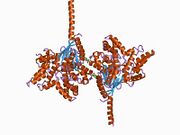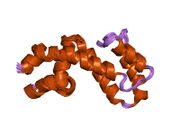Biology:RGS4
 Generic protein structure example |
Regulator of G protein signaling 4 also known as RGP4 is a protein that in humans is encoded by the RGS4 gene. RGP4 regulates G protein signaling.[1]
Function
Regulator of G protein signalling (RGS) family members are regulatory molecules that act as GTPase activating proteins (GAPs) for G alpha subunits of heterotrimeric G proteins.[2] RGS proteins are able to deactivate G protein subunits of the Gi alpha, Go alpha and Gq alpha subtypes. They drive G proteins into their inactive GDP-bound forms. Regulator of G protein signaling 4 belongs to this family. All RGS proteins share a conserved 120-amino acid sequence termed the RGS domain which conveys GAP activity.[3] Regulator of G protein signaling 4 protein is 37% identical to RGS1 and 97% identical to rat Rgs4. This protein negatively regulates signaling upstream or at the level of the heterotrimeric G protein and is localized in the cytoplasm.[1]
Clinical significance
A number of studies associate the RGS4 gene with schizophrenia,[4][5][6][7] while some fail to detect an association.[8]
RGS4 is also of interest as one of the three main RGS proteins (along with RGS9 and RGS17) involved in terminating signalling by the mu opioid receptor,[9] and may be important in the development of tolerance to opioid drugs.[10][11][12][13][14]
Inhibitors
Interactions
RGS4 has been shown to interact with:
References
- ↑ 1.0 1.1 "Entrez Gene: RGS4 regulator of G-protein signalling 4". https://www.ncbi.nlm.nih.gov/sites/entrez?Db=gene&Cmd=ShowDetailView&TermToSearch=5999.
- ↑ "GAIP and RGS4 are GTPase-activating proteins for the Gi subfamily of G protein alpha subunits.". Cell 86 (3): 445–52. 1996. doi:10.1016/S0092-8674(00)80117-8. PMID 8756726.
- ↑ "The regulators of G protein signaling (RGS) domains of RGS4, RGS10, and GAIP retain GTPase activating protein activity in vitro". Proc. Natl. Acad. Sci. U.S.A. 94 (14): 7216–20. July 1997. doi:10.1073/pnas.94.14.7216. PMID 9207071. Bibcode: 1997PNAS...94.7216P.
- ↑ "Association of RGS4 variants with schizotypy and cognitive endophenotypes at the population level". Behavioral and Brain Functions 4: 46. 2008. doi:10.1186/1744-9081-4-46. PMID 18834502.
- ↑ "RGS4 Polymorphisms Associated With Variability of Cognitive Performance in a Family-Based Schizophrenia Sample". Schizophrenia Bulletin 36 (5): 983–90. March 2009. doi:10.1093/schbul/sbp002. PMID 19282471.
- ↑ "Recent advances in postmortem pathology and neurochemistry in schizophrenia". Current Opinion in Psychiatry 22 (2): 154–60. March 2009. doi:10.1097/YCO.0b013e328323d52e. PMID 19553869.
- ↑ "Expression of RGS4 splice variants in dorsolateral prefrontal cortex of schizophrenic and bipolar disorder patients". Biological Psychiatry 65 (6): 541–5. March 2009. doi:10.1016/j.biopsych.2008.10.026. PMID 19041089.
- ↑ "Regulator of G-protein signalling 4 expression is not altered in the prefrontal cortex in schizophrenia". The Australian and New Zealand Journal of Psychiatry 42 (8): 740–5. August 2008. doi:10.1080/00048670802206338. PMID 18622782.
- ↑ "A role of RGS proteins in drug addiction". Biochemical Pharmacology 75 (1): 76–84. January 2008. doi:10.1016/j.bcp.2007.07.045. PMID 17880927.
- ↑ "Generation and characterization of Rgs4 mutant mice". Molecular and Cellular Biology 25 (10): 4221–8. May 2005. doi:10.1128/MCB.25.10.4221-4228.2005. PMID 15870291.
- ↑ "Effector antagonism by the regulators of G protein signalling (RGS) proteins causes desensitization of mu-opioid receptors in the CNS". Psychopharmacology 180 (1): 1–11. June 2005. doi:10.1007/s00213-005-2248-9. PMID 15830230.
- ↑ "Selective interactions between G protein subunits and RGS4 with the C-terminal domains of the mu- and delta-opioid receptors regulate opioid receptor signaling". Cellular Signalling 18 (6): 771–82. June 2006. doi:10.1016/j.cellsig.2005.07.003. PMID 16120478.
- ↑ "Regulator of G protein signaling 4 confers selectivity to specific G proteins to modulate mu- and delta-opioid receptor signaling". Cellular Signalling 21 (7): 1218–28. July 2009. doi:10.1016/j.cellsig.2009.03.013. PMID 19324084.
- ↑ "Differential Modulation of {micro}- and {delta}-Opioid Receptor Agonists by Endogenous RGS4 Protein in SH-SY5Y Cells". The Journal of Biological Chemistry 284 (27): 18357–67. July 2009. doi:10.1074/jbc.M109.015453. PMID 19416973.
- ↑ "Structure-based design, synthesis, and activity of peptide inhibitors of RGS4 GAP activity". Regulators of G-Protein Signaling, Part A. Methods in Enzymology. 389. 2004. pp. 266–77. doi:10.1016/S0076-6879(04)89016-5. ISBN 9780121827946.
- ↑ "Identification of small-molecule inhibitors of RGS4 using a high-throughput flow cytometry protein interaction assay". Molecular Pharmacology 71 (1): 169–75. January 2007. doi:10.1124/mol.106.028670. PMID 17012620.
- ↑ "RGS4 and RGS2 bind coatomer and inhibit COPI association with Golgi membranes and intracellular transport". Mol. Biol. Cell 11 (9): 3155–68. 2000. doi:10.1091/mbc.11.9.3155. PMID 10982407.
- ↑ "Identification of novel ErbB3-interacting factors using the split-ubiquitin membrane yeast two-hybrid system". Genome Res. 13 (7): 1744–53. 2003. doi:10.1101/gr.1276503. PMID 12840049.
- ↑ "RGS16 inhibits signalling through the G alpha 13-Rho axis". Nat. Cell Biol. 5 (12): 1095–103. December 2003. doi:10.1038/ncb1065. PMID 14634662. https://zenodo.org/record/1233351.
- ↑ "Expression of GTPase-deficient Gialpha2 results in translocation of cytoplasmic RGS4 to the plasma membrane". J. Biol. Chem. 273 (29): 18405–10. 1998. doi:10.1074/jbc.273.29.18405. PMID 9660808.
Further reading
- "GAIP and RGS4 are GTPase-activating proteins for the Gi subfamily of G protein alpha subunits.". Cell 86 (3): 445–52. 1996. doi:10.1016/S0092-8674(00)80117-8. PMID 8756726.
- "Making the case for a candidate vulnerability gene in schizophrenia: Convergent evidence for regulator of G-protein signaling 4 (RGS4).". Biol. Psychiatry 60 (6): 534–7. 2006. doi:10.1016/j.biopsych.2006.04.028. PMID 16860780.
- "Inhibition of G-protein-mediated MAP kinase activation by a new mammalian gene family.". Nature 379 (6567): 742–6. 1996. doi:10.1038/379742a0. PMID 8602223. Bibcode: 1996Natur.379..742D. https://zenodo.org/record/1233178.
- "RGS2/G0S8 is a selective inhibitor of Gqalpha function.". Proc. Natl. Acad. Sci. U.S.A. 94 (26): 14389–93. 1998. doi:10.1073/pnas.94.26.14389. PMID 9405622.
- "RGS proteins provide biochemical control of agonist-evoked [Ca2+]i oscillations". Mol. Cell 7 (3): 651–60. March 2001. doi:10.1016/S1097-2765(01)00211-8. PMID 11463389.
- "Regulator of G protein signaling (RGS16) inhibits hepatic fatty acid oxidation in a carbohydrate response element-binding protein (ChREBP)-dependent manner". J Biol Chem 286 (17): 15116–15125. 2011. doi:10.1074/jbc.M110.216234. PMID 21357625.
- "The regulators of G protein signaling (RGS) domains of RGS4, RGS10, and GAIP retain GTPase activating protein activity in vitro". Proc. Natl. Acad. Sci. U.S.A. 94 (14): 7216–20. July 1997. doi:10.1073/pnas.94.14.7216. PMID 9207071. Bibcode: 1997PNAS...94.7216P.
- "Ca2+/Calmodulin reverses phosphatidylinositol 3,4, 5-trisphosphate-dependent inhibition of regulators of G protein-signaling GTPase-activating protein activity". J. Biol. Chem. 275 (25): 18962–8. June 2000. doi:10.1074/jbc.M001128200. PMID 10747990.
- "Plasma membrane localization is required for RGS4 function in Saccharomyces cerevisiae.". Proc. Natl. Acad. Sci. U.S.A. 95 (10): 5584–9. 1998. doi:10.1073/pnas.95.10.5584. PMID 9576926. Bibcode: 1998PNAS...95.5584S.
- "Expression of GTPase-deficient Gialpha2 results in translocation of cytoplasmic RGS4 to the plasma membrane.". J. Biol. Chem. 273 (29): 18405–10. 1998. doi:10.1074/jbc.273.29.18405. PMID 9660808.
- "Genome scan of European-American schizophrenia pedigrees: results of the NIMH Genetics Initiative and Millennium Consortium.". Am. J. Med. Genet. 81 (4): 290–5. 1998. doi:10.1002/(SICI)1096-8628(19980710)81:4<290::AID-AJMG3>3.0.CO;2-Y. PMID 9674973.
- "RGSZ1, a Gz-selective RGS protein in brain. Structure, membrane association, regulation by Galphaz phosphorylation, and relationship to a Gz gtpase-activating protein subfamily.". J. Biol. Chem. 273 (40): 26014–25. 1998. doi:10.1074/jbc.273.40.26014. PMID 9748280.
- "A genome-wide search for schizophrenia susceptibility genes.". Am. J. Med. Genet. 81 (5): 364–76. 1998. doi:10.1002/(SICI)1096-8628(19980907)81:5<364::AID-AJMG4>3.0.CO;2-T. PMID 9754621.
- "Modulation of the affinity and selectivity of RGS protein interaction with G alpha subunits by a conserved asparagine/serine residue.". Biochemistry 38 (24): 7773–9. 1999. doi:10.1021/bi9906367. PMID 10387017.
- "Palmitoylation of a conserved cysteine in the regulator of G protein signaling (RGS) domain modulates the GTPase-activating activity of RGS4 and RGS10.". J. Biol. Chem. 274 (53): 38260–7. 2000. doi:10.1074/jbc.274.53.38260. PMID 10608901.
- "1H, 15N, 13C, and 13CO assignments and secondary structure determination of RGS4.". J. Biomol. NMR 15 (4): 339–40. 2000. doi:10.1023/A:1008343609739. PMID 10685342.
- "Ca2+/Calmodulin reverses phosphatidylinositol 3,4, 5-trisphosphate-dependent inhibition of regulators of G protein-signaling GTPase-activating protein activity.". J. Biol. Chem. 275 (25): 18962–8. 2000. doi:10.1074/jbc.M001128200. PMID 10747990.
- "Genome-wide scan for schizophrenia in the Finnish population: evidence for a locus on chromosome 7q22.". Hum. Mol. Genet. 9 (7): 1049–57. 2000. doi:10.1093/hmg/9.7.1049. PMID 10767329.
- "Location of a major susceptibility locus for familial schizophrenia on chromosome 1q21-q22.". Science 288 (5466): 678–82. 2000. doi:10.1126/science.288.5466.678. PMID 10784452. Bibcode: 2000Sci...288..678B.
- "Cytoplasmic, nuclear, and golgi localization of RGS proteins. Evidence for N-terminal and RGS domain sequences as intracellular targeting motifs.". J. Biol. Chem. 275 (31): 24013–21. 2000. doi:10.1074/jbc.M002082200. PMID 10791963.
- "Novel alternative splicing and nuclear localization of human RGS12 gene products.". J. Biol. Chem. 275 (38): 29660–71. 2000. doi:10.1074/jbc.M000330200. PMID 10869340.
- "GTPase-activating proteins for heterotrimeric G proteins: regulators of G protein signaling (RGS) and RGS-like proteins". Annual Review of Biochemistry 69: 795–827. 2000. doi:10.1146/annurev.biochem.69.1.795. PMID 10966476.
- "Evolution of the regulators of G-protein signaling multigene family in mouse and human". Genomics 79 (2): 177–85. 2002. doi:10.1006/geno.2002.6693. PMID 11829488.
- "RGS4 and RGS2 bind coatomer and inhibit COPI association with Golgi membranes and intracellular transport.". Mol. Biol. Cell 11 (9): 3155–68. 2000. doi:10.1091/mbc.11.9.3155. PMID 10982407.
- "Determination of the contact energies between a regulator of G protein signaling and G protein subunits and phospholipase C beta 1.". Biochemistry 40 (2): 414–21. 2001. doi:10.1021/bi001923+. PMID 11148035.
- "RGS4 inhibits platelet-activating factor receptor phosphorylation and cellular responses.". Biochemistry 40 (12): 3583–8. 2001. doi:10.1021/bi0019242. PMID 11297424.
 |




